Explore Yichang - China Travel, Asia
Nestled in the heart of Hubei Province, Yichang stands as a vibrant gateway to China's natural and cultural heritage. This city, often referred to as the "Gateway to the Three Gorges," offers a unique blend of historical charm and modern appeal. Yichang is renowned for its picturesque landscapes, rich history, and warm hospitality, making it a must-visit destination for travelers exploring China. Whether you're drawn by the awe-inspiring Three Gorges Dam or the cultural vibrancy of local festivals, Yichang promises an unforgettable experience.
Population: Approximately 4 million in 2020.
Economy: The economy hub in the western of Hubei province with the dominant industries are shipping and shipbuilding.
Landmarks: Famous for the Gezhouba Dam, Three Gorges Dam-the world largest hydroelectric power station, and Shennongjia Forest Area.
China

Overview of Yichang
History & Culture Influence
Yichang boasts a long and storied history, dating back over 2,700 years. As an ancient city, it has played an important role in China's development, particularly as a key port along the Yangtze River. The rich culture of Yichang is heavily influenced by the Tujia ethnic group, one of China's recognized ethnic minorities. The Tujia people have preserved their unique traditions, from folk songs to intricate embroidery, adding a rich cultural tapestry to the city. Visiting Yichang offers a chance to explore this heritage, providing insight into the customs and traditions that have shaped the region.
Interaction with The Locals
Yichang is home to approximately 4 million residents. The city’s population is a diverse mix, with a significant number of Han Chinese and ethnic minorities, including the Tujia people. Yichang's citizens are known for their warm hospitality and strong sense of community. This blend of cultures contributes to the city's vibrant local life, where traditional customs coexist with modern lifestyles.
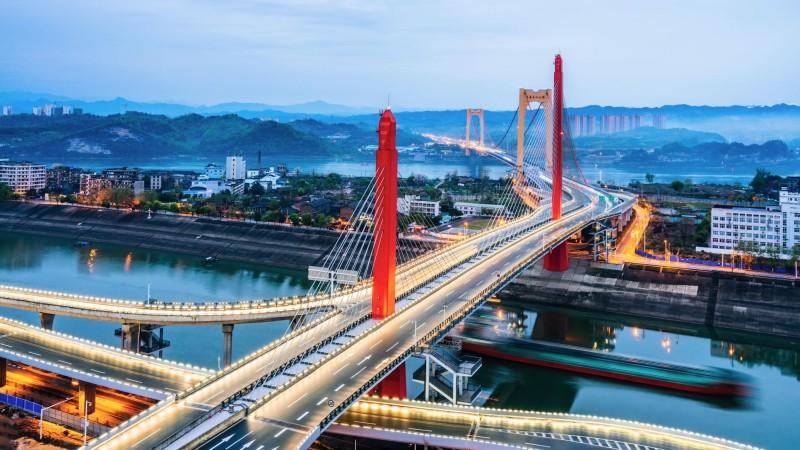
Yichang, Hubei Province - © Facts.net
Top Attractions in Yichang
- Three Gorges Dam: The Three Gorges Dam is Yichang's most iconic landmark and a marvel of modern engineering. As the world's largest hydroelectric power station, it offers breathtaking views and fascinating insights into China's technological advancements. Visitors can explore the dam's observation points, museums, and surrounding scenic areas, making it a must-see attraction in Yichang.
- Gezhouba Dam: Another significant site is the Gezhouba Dam, an earlier but equally impressive engineering feat. It was the first large-scale dam built on the Yangtze River and remains an essential part of the region's infrastructure. The Gezhouba Dam area also offers beautiful natural scenery, including lush parks and peaceful river views.
- Sanyou Cave: For a taste of Yichang's natural beauty and cultural history, Sanyou Cave is an excellent destination. This cave is famous for its stunning rock formations and ancient inscriptions. It is said that three famous poets from the Tang Dynasty visited this site, leaving behind writings that add to its historical allure. The cave's serene environment and historical significance make it a popular spot for both nature lovers and history enthusiasts.
- Yiling Square: Yiling Square is a bustling urban hub that serves as a focal point for locals and visitors alike. Surrounded by shops, restaurants, and cultural institutions, the square is an excellent place to experience Yichang's modern vibe. It also presents a range of cultural events and shows that offer an insight into the modern art scene in the city.
- Shennongjia Forest Area: A UNESCO World Heritage Site, the Shennongjia Forest Area is a vast nature reserve known for its diverse flora and fauna. It's a paradise for hikers and nature enthusiasts, offering breathtaking landscapes, rare wildlife, and numerous trails. The area is also steeped in legends and folklore, adding a mystical element to its natural beauty.
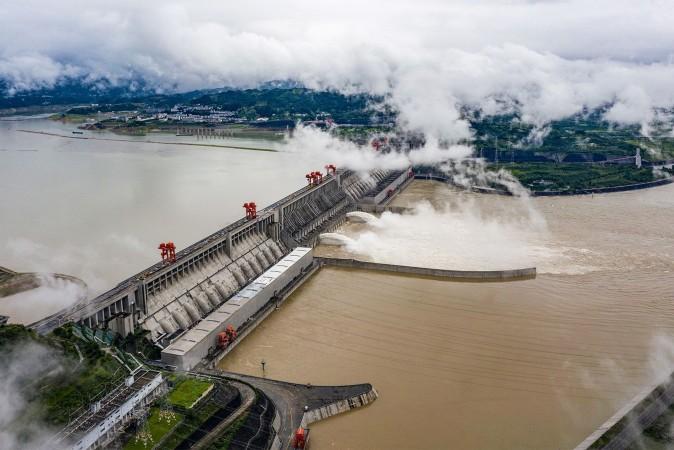
Three Gorges Dam - © CNN
Must-Try Dishes in Yichang
Yichang offers a delightful culinary journey that showcases the rich flavors and traditions of Hubei cuisine. The following meals are a must-try and showcase the city's distinct culinary heritage:
- Yichang Fish Cake: A local specialty, Yichang Fish Cake is made from fresh fish, minced and mixed with seasonings, then shaped into cakes and fried. The result is a crispy fish cake outside and a soft, tasty within. It's often served with a tangy dipping sauce, making it a favorite among both locals and visitors.
- Tujia-style Hot Pot: Experience the warmth of Tujia hospitality with Tujia-style Hotpot, a traditional dish featuring a bubbling pot of rich broth filled with meats, vegetables, and tofu. What sets this hotpot apart is the use of local herbs and spices, which add a distinctive flavor. It's a communal dish, perfect for sharing with friends and family.
- Steamed Glutinous Rice with Ribs: A comforting dish, Steamed Glutinous Rice with Ribs combines tender pork ribs with sticky rice, steamed together with a variety of aromatic spices. This dish is hearty and satisfying, with the rice absorbing the flavors of the meat and spices, creating a deliciously rich taste.
- Doupi (Bean Skin Roll): Doupi, or Bean Skin Roll, is a popular street food in Yichang. It consists of a thin layer of bean curd skin wrapped around a filling of glutinous rice, mushrooms, and sometimes minced pork. The roll is then pan-fried until crispy. It's a perfect snack or a light meal, showcasing the local love for creative, flavorful dishes.
- Xiahe Fish: Xiahe Fish is a Yichang specialty known for its tender and delicate flavor. The dish features fresh fish from the Xiahe River, cooked in a savory sauce with ginger, garlic, and green onions. The simplicity of the ingredients allows the natural taste of the fish to shine, making it a must-try for seafood lovers.
- Braised Pork Belly: Yichang's version of Braised Pork Belly is a rich and savory dish that showcases the local love for hearty flavors. The pork belly is slow-cooked with soy sauce, sugar, and a blend of aromatic spices until it becomes tender and flavorful. It's often served with steamed rice or buns, making it a comforting and filling dish.
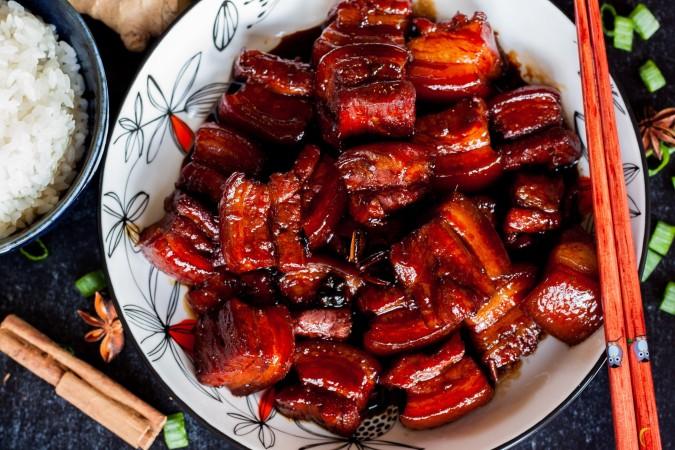
Braised Pork Belly - © The Mini Chef
Festivals & Local Celebrations
Yichang is a city that loves to celebrate its rich cultural heritage through various festivals and events. These celebrations offer a glimpse into the traditions and communal spirit of the local people.
Dragon Boat Festival
The Dragon Boat Festival is one of the most vibrant celebrations in Yichang, held annually in honor of the ancient poet Qu Yuan. The festival features dragon boat races on the Yangtze River, where teams paddle in beautifully decorated boats to the beat of drums. It's a lively event filled with excitement and cultural significance, also marked by the consumption of zongzi, a traditional sticky rice dumpling.
Tujia Ethnic Festivals
The Tujia ethnic group, a significant cultural presence in Yichang, celebrates a variety of unique festivals. One such event is the Sheba Festival, a traditional gathering that includes folk dancing, singing, and ceremonies to honor ancestors. These festivals are vibrant displays of Tujia customs and are a wonderful opportunity for visitors to experience local traditions.
Lantern Festival
The Lantern Festival marks the end of the Chinese New Year celebrations and is celebrated with great enthusiasm in Yichang. The city is adorned with beautiful lanterns, and people gather to watch traditional performances, eat tangyuan (sweet rice balls), and enjoy fireworks. This festival symbolizes the arrival of spring and the reunion of family and friends.
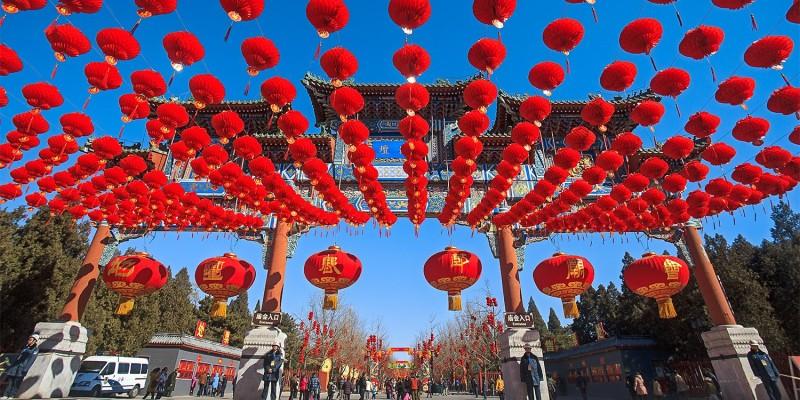
Yichang Lantern Festival - © VietnamNet
What to Do in Yichang
Yichang offers a wide range of activities for tourists, from exploring natural wonders to engaging in cultural experiences. Here's a glimpse of what you can do in this captivating city:
- Yangtze River Cruises: A Yangtze River cruise is a must-do activity when visiting Yichang. These cruises offer breathtaking views of the river's iconic landscapes, including the Three Gorges.
- Hiking and Outdoor Adventures: For nature enthusiasts, Yichang offers excellent hiking opportunities. The Shennongjia Forest Area is a popular destination for trekking, known for its diverse flora and fauna. Additionally, the nearby Three Gorges area offers scenic trails that provide spectacular views of the gorges and the Yangtze River.
- Traditional Chinese Tea Ceremonies: Yichang's tea culture is deeply rooted in its history, and attending a tea ceremony offers insight into the art of tea-making and the social customs surrounding it. It's a peaceful and educational experience that highlights the importance of tea in Chinese culture.
- River Rafting and Water Sports: For those seeking adventure, Yichang's rivers provide excellent opportunities for water sports. River rafting, especially in the more turbulent sections of the Yangtze, offers an exhilarating experience. Kayaking and paddleboarding are also popular activities, allowing visitors to enjoy the river's beauty from a unique perspective.
Shopping in Yichang
- Yichang Night Market: For a lively and authentic shopping experience, visit the Yichang Night Market. This vibrant spot is perfect for picking up unique souvenirs like Tujia ethnic crafts and street food. The vibrant ambiance of the market provides a glimpse of the creativity and culture of the area.
- Wanda Plaza: One of the best places to shop in the city is Wanda Plaza, which has both domestic and foreign brands. With its wide range of stores, dining options, and entertainment facilities, it's ideal for a comprehensive shopping experience.
- Yiling Square Shopping Mall: Located centrally, Yiling Square Shopping Mall offers fashion, electronics, and home goods. It's a great place to explore local and international brands, with plenty of cafes and restaurants for a relaxing break.
- Specialty Tea Shops: Explore Yichang's tea culture by visiting specialty tea shops. These stores offer high-quality local teas like Yichang Maojian and provide insights into traditional tea-making practices.
- Traditional Chinese Medicine Stores: Visit your local businesses that sell herbal cures and health goods to learn about traditional Chinese medicine. It's a unique chance to learn about traditional practices and find natural health products.
- Local Food Markets: Experience Yichang’s culinary delights at local food markets. Purchase fresh produce, regional specialties, and local snacks like dried river shrimp and noodles, offering a taste of Yichang's vibrant food culture.
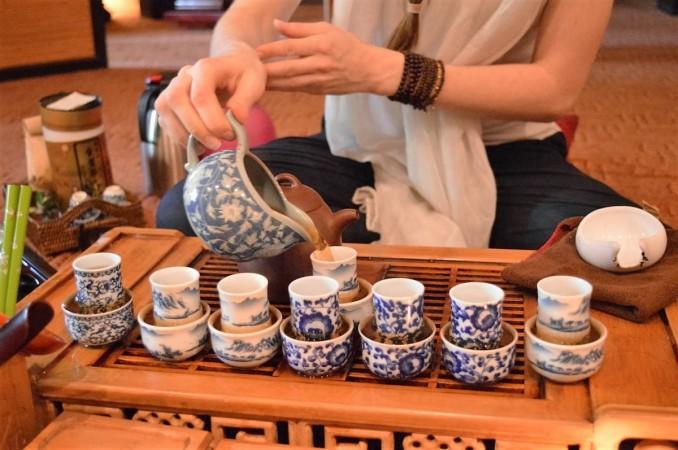
Experience Chinese tea ceremony - © UP FOR A CUP
Weather in Yichang: Best Time to Visit
Yichang experiences a subtropical climate with distinct seasons, influencing the tourism trends throughout the year. Here’s a breakdown of the weather and what to expect in each season:
Spring in Yichang
Spring in Yichang is mild and pleasant, with temperatures ranging from 10°C to 22°C (50°F to 72°F). This season is ideal for outdoor activities, as the weather is comfortable and the natural scenery is lush and blooming. It’s a popular time for tourists to visit, especially for exploring the Yangtze River, enjoying river cruises, and taking in the vibrant natural landscapes. The mild temperatures also make it a great season for hiking and visiting local attractions.
Summer in Yichang
Summer in Yichang can be hot and humid, with temperatures often reaching 25°C to 35°C (77°F to 95°F). This season also marks the rainy period, with frequent showers and high humidity. Despite the heat, summer is a peak time for river cruises on the Yangtze River, as the lush surroundings are at their greenest. Visitors also flock to local festivals and outdoor activities, making it a vibrant season for experiencing Yichang's cultural events and natural beauty.
Autumn in Yichang
Autumn brings cooler temperatures, ranging from 15°C to 25°C (59°F to 77°F). The weather is generally dry and clear, making it an excellent time for sightseeing and outdoor exploration. This season sees a drop in tourist numbers, offering a more relaxed experience at popular attractions. The fall foliage adds a picturesque quality to the city’s landscapes, making it a favored time for photographers and nature lovers.
Winter in Yichang
Winter in Yichang is relatively mild, with temperatures ranging from 5°C to 15°C (41°F to 59°F). While it is cooler, it rarely snows, and the weather remains suitable for travel. Winter is a quieter time for tourism, offering a peaceful atmosphere to explore the city’s attractions without the crowds. It's an ideal season for enjoying indoor activities, visiting museums, and experiencing the local cuisine in a cozy setting.
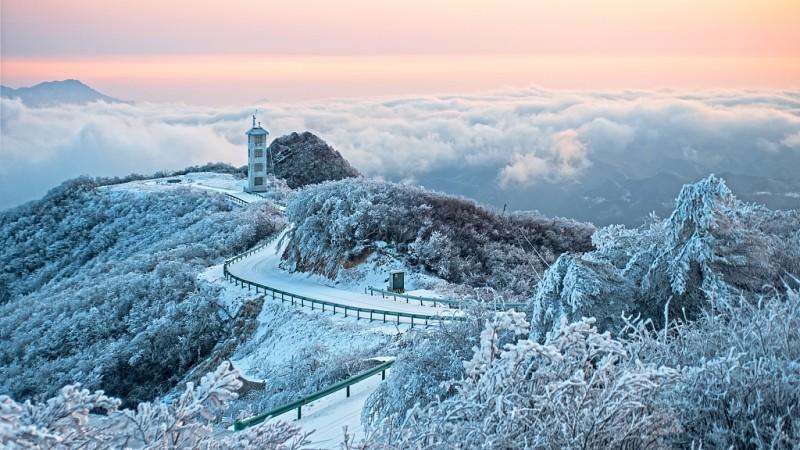
Winter in Yichang - © CGTN
Essential Travel Information
Getting Around Yichang
Yichang offers a range of transportation options to help you explore the city and its surroundings efficiently:
- Public Transit: Yichang has a well-developed public transportation system, including buses and a metro line. The city’s bus network covers major attractions and neighborhoods, while the metro provides a quick and convenient way to travel within the city.
- Taxis and Ride-Sharing: In Yichang, taxis are widely accessible and provide a practical means of transportation across the city. Ride-sharing apps are also popular, providing an alternative to traditional taxis. To help in communication with drivers, make sure the destination is stated in Chinese.
- Bicycles and E-Scooters: For a more flexible and eco-friendly option, consider renting bicycles or e-scooters. Many areas in Yichang have dedicated lanes for cycling, and renting these modes of transport allows you to explore the city at your own pace.
- Trains and Buses for Regional Travel: To explore beyond Yichang, you can take trains or long-distance buses to nearby cities and attractions. The Yichang Railway Station connects to major cities like Wuhan and Chongqing, while buses offer routes to scenic areas and neighboring provinces.
ATM & Banking Services
Accessing banking services in Yichang is convenient with numerous ATMs available throughout the city, including at shopping centers and tourist spots. These ATMs provide multilingual services and accept foreign credit cards. For banking needs such as currency exchange and cash withdrawals, several banks are open from Monday to Friday, with some branches open on Saturdays. Currency exchange services can also be found at hotels and dedicated counters. Most establishments accept major credit and debit cards, but it's a good idea to carry some cash for smaller vendors and markets where card payments may not be accepted.
Where to Stay in Yichang
Yichang offers a range of accommodation options to suit different preferences and budgets:
- Luxury Hotels: These places include upscale features including tasteful eating options, luxurious accommodations, and first-rate service. They are well-located for easy access to major attractions and offer stunning views of the Yangtze River.
- Mid-Range Hotels: There are numerous mid-range hotels in Yichang that provide comfort and value for money where you can experience comfortable rooms, modern amenities, and convenient locations, making them suitable for both leisure and business travelers.
- Budget Accommodation: For budget-conscious travelers, Yichang has various hostels and guesthouses with affordable rates with basic amenities. For tourists seeking affordable, basic lodging, these choices are perfect.
- Boutique Hotels: Yichang also features charming boutique hotels that offer a unique and personalized stay. These places provide distinctive décor, local charm, and a more intimate atmosphere, perfect for travelers seeking a special experience.
Articles for you

Explore Luang Prabang - Laos Travel, Asia
Luang Prabang, nestled in northern Laos at the meeting point of the Mekong river and Nam Khan river, is a city celebrated for its rich cultural heritage and stunning natural beauty. Recognized as a UNESCO World Heritage Site in 1995, it boasts a unique blend of traditional Lao and French architecture that has been carefully preserved. Whether you're wandering through its ancient temples, admiring the local architecture, or soaking in the natural beauty of waterfalls and rivers, Luang Prabang offers something for everyone.
Population: Approximately 470,000 in 2020.
Economy: Luang Prabang's economy thrives on tourism, with its UNESCO status drawing visitors to its temples, natural wonders, and cultural experiences. Local crafts, hospitality, and small businesses also play vital roles, supporting the town's sustainable growth. Local crafts, hospitality, and small businesses also play vital roles, supporting the town's sustainable growth.
Landmarks: Famous for the Wat Xieng Thong, Royal Palace Museum (also known as Haw Kham), and Mount Phousi (Phou Si Hill).Luang Prabang, nestled in northern Laos at the meeting point of the Mekong river and Nam Khan river, is a city celebrated for its rich cultural heritage and stunning natural beauty. Recognized as a UNESCO World Heritage Site in 1995, it boasts a unique blend of traditional Lao and French architecture that has been carefully preserved. Whether you're wandering through its ancient temples, admiring the local architecture, or soaking in the natural beauty of waterfalls and rivers, Luang Prabang offers something for everyone.
Population: Approximately 470,000 in 2020.
Economy: Luang Prabang's economy thrives on tourism, with its UNESCO status drawing visitors to its temples, natural wonders, and cultural experiences. Local crafts, hospitality, and small businesses also play vital roles, supporting the town's sustainable growth. Local crafts, hospitality, and small businesses also play vital roles, supporting the town's sustainable growth.
Landmarks: Famous for the Wat Xieng Thong, Royal Palace Museum (also known as Haw Kham), and Mount Phousi (Phou Si Hill).

Explore Vientiane - Laos Travel, Asia
Vientiane, the capital of Laos, offers a unique travel experience for those looking to explore a peaceful Southeast Asian city with a deep connection to its cultural roots. Unlike other bustling capitals, Vientiane boasts a serene and laid-back atmosphere, making it a perfect destination for travelers wanting to escape the chaos of more crowded cities. This charming city sits along the Mekong River, offering scenic views, rich history, and a vibrant yet tranquil way of life. As a gateway to exploring Laos, this capital invites you to slow down, immerse in its heritage, and enjoy the local flavors.
Population: Approximately 840,000 in 2023.
Economy: Vientiane's economy is growing steadily, driven by government services, trade, and tourism. Key sectors include agriculture, manufacturing, and construction. The city's strategic location along the Mekong River supports trade with neighboring Thailand and Vietnam.
Landmarks: Famous for the Pha That Luang, Patuxai, and the Buddha Park (or Wat Xieng Khuan).

Explore Zanzibar - Tanzania Travel, Africa
Zanzibar, an enchanting archipelago in the Indian Ocean, lies about 40 kilometers off Tanzania’s eastern coast. Comprising several islands, with Unguja (commonly known as Zanzibar Island) and Pemba Island being the largest, Zanzibar is celebrated for its stunning beaches, rich cultural heritage, and historical significance. Just south of the equator, this tropical paradise enjoys a warm climate year-round, attracting visitors with its blend of African, Arab, and Indian influences. Whether exploring spice farms, snorkeling in crystal-clear waters, or savoring local dishes like biryani and Zanzibar pizza, travelers find Zanzibar a captivating destination.
Population: Estimate 30,000 people in 2024
Economy: Zanzibar's economy relies heavily on tourism, agriculture, and fishing. The island is known for its spice production, particularly cloves, and attracts visitors with its rich culture and beautiful beaches. Tourism is the largest contributor, driving growth and development.
Landmarks: Famous for the Stone Town, Prison Island ( or Changuu Island), and the Jozani Forest (an important part of the Jozani Chwaka Bay National Park).

Explore Arusha - Tanzania Travel, Africa
Arusha, nestled at the base of Mount Meru in northern Tanzania, is the gateway to some of Africa's most iconic national parks, including the Serengeti and Ngorongoro Crater. Known as the "Safari Capital," this bustling city boasts a vibrant blend of cultures, with influences from indigenous African, Arab, and Indian communities that enrich its lively markets and diverse culinary scene. With its temperate climate, rich history, and dynamic population, Arusha is a must-visit destination for those looking to explore the heart of Tanzania's northern safari circuit.
Population: Estimate 700,000 people in 2024
Economy: Arusha's economy thrives on tourism, agriculture, and small-scale trade. As the gateway to major national parks like Serengeti and Kilimanjaro, it attracts safari-goers. Coffee and flower farming also contribute significantly to its local and export markets.
Landmarks: Famous for Mount Meru, Arusha National Park, and the Chemka Hot Springs.

Explore Loikaw - Myanmar Travel, Asia
Nestled in the heart of Kayah State, Loikaw is a hidden gem waiting to be discovered. For travelers seeking an authentic experience, this small yet culturally rich city offers a unique window into Myanmar’s lesser-known beauty. Located in Southeast Myanmar, Loikaw remains relatively untouched by mass tourism, making it an ideal destination for those looking to explore off the beaten path. From stunning landscapes to rich cultural traditions, Loikaw tourism promises visitors an enriching adventure where they can immerse themselves in the vibrant local life, breathtaking views, and historical landmarks.
Population: Approximately 51,000 in 2019.
Economy: Loikaw's economy is primarily based on agriculture, with rice, corn, and millet as main crops. Traditional crafts and tourism are also growing sectors, contributing to the region's economic development.
Landmarks: Famous for the Dhow Shipyard, Ras Al Jinz Turtle Reserve, and the Al Ayjah Lighthouse.

Explore Matsumoto - Japan Travel, Asia
Nestled in the heart of Nagano Prefecture, Matsumoto is a captivating city that offers a blend of traditional Japanese charm and stunning natural beauty. Surrounded by the majestic Japanese Alps, it’s the perfect destination for travelers seeking an authentic and peaceful experience. From its iconic Matsumoto Castle to its vibrant local festivals, Matsumoto is a destination that caters to all kinds of travelers. The city offers the warmth of small-town Japan, with friendly locals and breathtaking landscapes waiting to be explored. Let's dive into everything that makes Matsumoto a must-visit destination for your next trip to Japan.
Population: Approximately 240,000 in 2019.
Economy: Matsumoto's economy focuses on a mix of tourism, agriculture, and local craftsmanship. The city is known for wasabi farming, traditional arts, and a growing role as a cultural and outdoor travel destination.
Landmarks: Famous for the Matsumoto Castle, Daio Wasabi Farm, and the Japan Ukiyo-e Museum.
